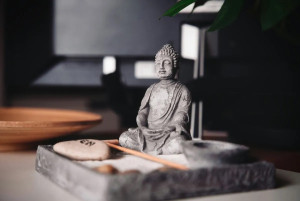The Hierophant is the sixth card in the series of the major arcana and is also recognized as the Pope and the High Priest. As an archetype, the Hierophant is a speaker of divine knowledge, although this card also signifies community, family, organizations, teachings, traditions and marriage.
Symbols & Characteristics
The Hierophant is associated with the zodiac sign Taurus. Taurus is a fixed Earth sign which is ruled by Venus and governs the ears, mouth, jaw, larynx and the thyroid gland. Red-orange, the herb sage and the musical note C# are also associated with this card. Although the Hierophant is the sixth card in the succession of the major arcana, it is represented by the number five; five correlates with mediation. Five, being the mid-point through the series of single digit numbers, also represents humankind, a mid-point between God and nature.The Hierophant, Pope or High Priest card depicts a spiritual leader acting as a vessel of divine information. This archetype bridges the spiritual realm and the physical realm by communicating sacred wisdom; two men stand before the Hierophant, receiving spiritual guidance.The red-orange of the Hierophant’s robe is a stark contrast to the grey background of this card. The bright garment signifies authority, dominion and power, while the grey stone of the room and the Hierophant’s throne represent wisdom and dispassion. Tucked underneath his bright robe, a blue garment pays homage to the intuitive wisdom of the High Priestess; kept close to him, it is kept hidden from the outside world. The white sleeves of his undergarments allude to purity. The Hierophant wears a triple crown symbolizing his connection to the wisdom of the divine. He holds a golden scepter in his left hand, also known as the receiving hand. Underneath the Hierophant’s triple crown are earflaps; one ear is covered, while the other is left open, beckoning one to recognize what they hear. With his right hand, the Hierophant makes the esoteric symbol representing the connection between the spiritual realm and the physical realm. Crosses on the Hierophant’s white shoes also allude to the bringing of divine knowledge to the physical realm.On the alter resting at the feet of the Hierophant rests a set of crossed keys signifying the unlocking of the male consciousness and the female consciousness. Atop the alter are also four circles, each with an X in the middle, signifying God and the four worlds He created. The black and white checkerboard pattern featured on the red alter are representational of balance, and when mixed create grey. Below the Hierophant, two disciples stand before him. One disciple wears a garment of roses representing the physical realm, while the other disciple dons a garment of lilies associated with the intellectual.
Reading The Hierophant Upright
The Hierophant represents wisdom and knowledge as well as religious doctrine, traditions, established order and divine law. Marriage, family, community and unity are also associated with this card. In a love or relationship reading, receiving this card may be an indication of a potential marriage. Upright in a tarot reading, the Hierophant may represent a figure who is a mentor, spiritual advisor or higher authority; this individual may have associations with religion or education.
Reading The Hierophant Reversed
The Hierophant reversed may represent an inflexible, intolerant authority figure, or an individual with corrupt advise, perverse spirituality or misguided information. Reviewing the information in question is advisable when this card pops up.



